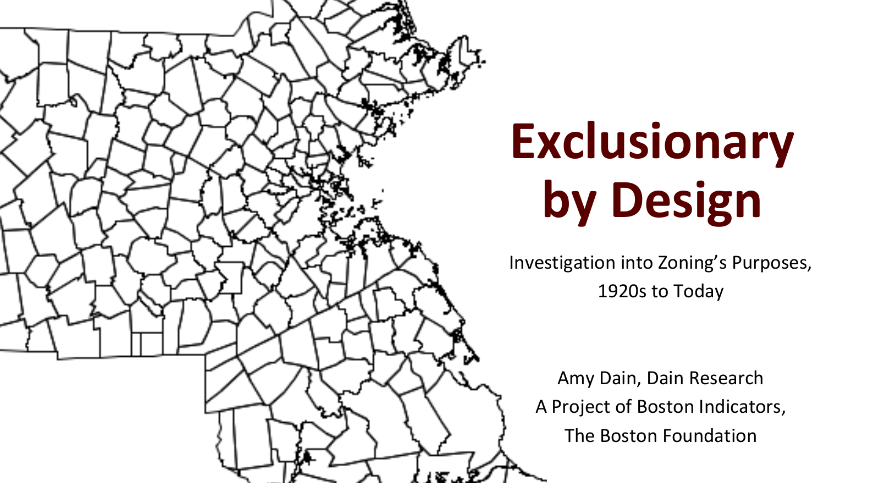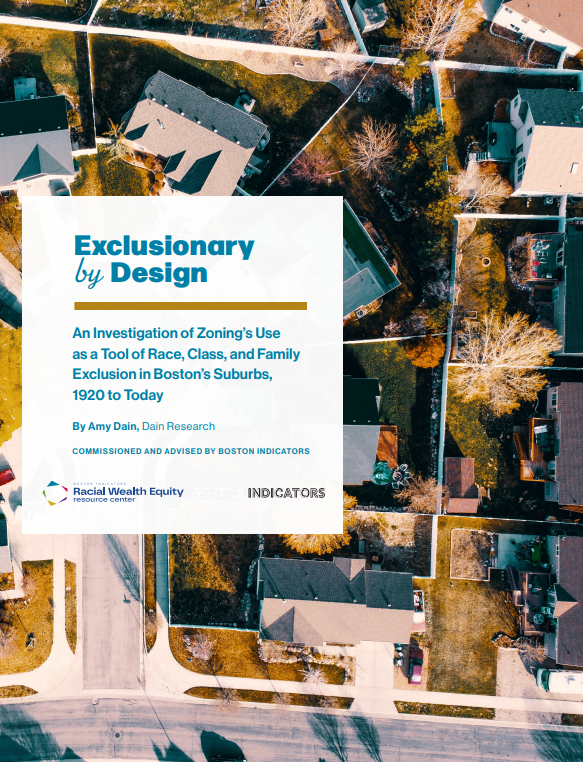Exclusionary by Design
An Investigation of Zoning’s Use as a Tool of Race, Class, and Family Exclusion in Boston’s Suburbs, 1920 to Today
November 8, 2023
Municipal zoning was the hot topic on November 8, 2023, with more than 800 people registered for the online forum to discuss the latest Boston Indicators–sponsored report, Exclusionary by Design: An Investigation of Zoning’s Use as a Tool of Race, Class, and Family Exclusion in Boston’s Suburbs, 1920 to Today. For this addition to the Racial Wealth Equity Resource Center, Indicators tapped noted zoning expert Amy Dain of Dain Research for a sweeping assessment of the history of zoning and the social and economic dynamics behind its evolution in the suburbs of eastern Massachusetts.
Zoning ordinances began in the early 20th century and the report covers 100 years of their impact in Massachusetts. During her visually engaging presentation, however, Dain focused on the midcentury era, when postwar growth booms were followed by a widespread, precipitous retraction in the “Big Downzone” of the 1970s. Apartments and multifamily residences were drastically restricted or banned throughout the Boston suburbs, even where they had been embraced formerly as part of a town’s fiscal strategy.
Dain methodically explored common rationales for the racial segregation that resulted from exclusionary zoning: that it was incidental to changes driven by environmental and anti-highway movements along with corrections to pell-mell postwar growth; that it was a product of class elitism alone; or that it was a product of class elitism and racism. While all of those were in play, her clear arguments put the weight of the blame on the latter.
Coming as it did just after major civil rights wins and as the Black population in the Boston area was growing through domestic and international migration, she argued, the Big Downzone was approved by people who knew the result of what they were voting for at town meetings, even when bylaw language said nothing overtly racist.
In conversation with Northeastern University Distinguished Professor of Public Policy and Urban Affairs Ted Landsmark and Boston Indicators Executive Director Luc Schuster after the presentation, Dain said in her work on this report (and two previous zoning reports since 2004) she’d seen a clear theme of a century of exclusion through zoning accompanied by a theme of people advocating to open things up, which she found moving even if it was rarely enough to turn the tide. Most municipalities’ official Growth Policy Statements requested by the state after the Big Downzone called for near zero growth. A minority set general goals for diversified density and greater inclusion, but on a project-by-project basis, the votes were not there to support it. Defense of the status quo has been strong.
As Landsmark said, “The research confirms what many Black and Brown residents have known for a long time,” noting how many of his Black professional peers had left the area altogether early in their careers because of the way past public actions and zoning served to exclude them from residential markets in communities adjacent to Boston, with their educational and economic opportunities. “But how do we use this research and understanding to move forward with solutions that go beyond lip service? Clearly this is a moment when we need to think seriously about legislative and policy change to allow diversification in the suburbs.”
Schuster raised the term municipal fragmentation, which the report explores as a governance structure that has led to segregation. In other words, having zoning and land-use decisions happening at the hyperlocal level doesn’t help the Commonwealth make progress. Landsmark pointed to the 40B and MBTA Communities legislation, statewide policies that take precedence over local bylaws and have already nudged status quo–mired municipalities in the direction of inclusion. “[These] suggest solutions need to be more regional or metropolitan…. This research highlights the need for very specific incentives for those who’ve used zoning for exclusion.” Dain agreed, adding that “in 2010, 40B was affirmed by voters statewide. It is in the whole region’s interest and people see that. At the local level though, it’s hard to overcome specific resistance.… Anything allowed has been incremental and surgical with a lot of negotiating and definitely not ‘meeting regional need’.”
Schuster posed a final two questions: What else should we research, and should we just end zoning? “Zoning is intrinsically exclusionary,” said Landsmark, “but unlikely to go away.” In the meantime, he suggested, we should look at disincentives for certain policies and what has worked elsewhere. For her part, Dain would like to spend more time examining how state laws impact local practice. Schuster closed by acknowledging the many unanswered questions that remained and sharing the hope that people left the conversation motivated to take action in their own spheres to redress the exclusion that zoning has generated.


